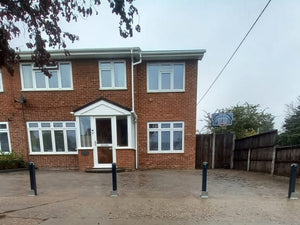
Guide to Heavy Duty Security Bollards for 2025
As we step into 2025, the need for robust physical security is more pressing than ever, with vehicle-related threats on the rise and urban environments constantly evolving. Heavy duty security bollards have become the frontline defence for properties, businesses, and public spaces, offering unmatched protection against ram raids, unauthorised access, and accidental impacts. This article is your comprehensive guide to selecting, installing, and maintaining heavy duty security bollards in 2025. We will explore the latest types, essential features, compliance considerations, best installation and maintenance practices, and future trends shaping the industry.
Understanding Heavy Duty Security Bollards
Heavy duty security bollards play a crucial role in safeguarding both private and public spaces across the UK. As incidents involving vehicle attacks and ram raids have increased, the need for sturdy, reliable barriers has never been more apparent. These bollards act as physical deterrents, protecting entrances, assets, and pedestrians from unauthorised vehicle access.
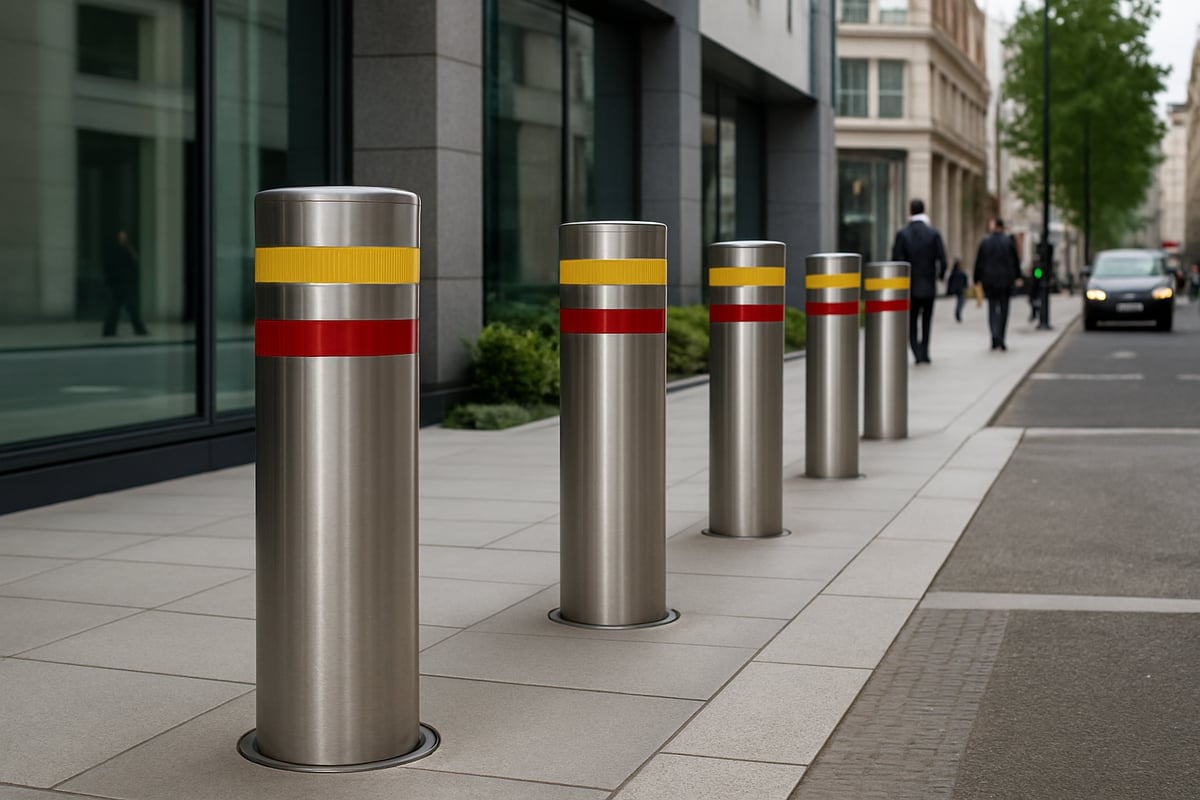
What Are Heavy Duty Security Bollards?
Heavy duty security bollards are robust, engineered barriers designed to withstand significant impact from vehicles. Unlike standard or decorative bollards, which often serve aesthetic or light organisational purposes, these are constructed specifically for security and safety.
Common use cases include protecting commercial premises, car parks, and public spaces. For example, retail parks and city centres often use heavy duty security bollards to prevent ram raid incidents. According to recent studies, sites equipped with these bollards have seen a marked reduction in such crimes.
Materials typically include high-grade steel, reinforced concrete, and aluminium. Each offers a balance between strength, durability, and resistance to environmental factors, ensuring long-term protection.
Types of Heavy Duty Security Bollards
There are several main types of heavy duty security bollards, each tailored to specific security needs:
- Fixed/static bollards: Permanently installed and ideal for constant security at vulnerable sites.
- Removable and retractable bollards: Offer flexibility, allowing access when needed, such as for deliveries or events.
- Telescopic bollards: Can be lowered into the ground when not in use, combining space-saving design with maximum protection.
- Automatic hydraulic or electric bollards: Integrate with access control systems, enabling remote operation for high-security environments.
- Anti-terror and anti-ram bollards: Engineered for maximum impact resistance, suitable for locations with elevated threat levels.
Visual distinctions also play a role. Colours like yellow and black, or red and white, increase visibility. Reflective markings and various finishes help bollards fit both aesthetic and safety requirements.
For an overview of available options and specifications, you can explore the Heavy Duty Security Bollards Collection, which showcases the diversity of modern solutions.
Key Benefits and Applications
The primary benefit of heavy duty security bollards is the robust security they provide against vehicle attacks, theft, and vandalism. These barriers form a strong first line of defence, significantly reducing the risk of unauthorised access.
Bollards also protect pedestrians by creating safe zones in busy urban settings. They shield infrastructure, such as building entrances and utilities, from accidental vehicle impacts. In addition, they are vital for traffic management and access control, guiding vehicles safely in shared spaces.
Real-world deployments demonstrate their effectiveness. For instance, local councils have reported fewer incidents of ram raids and improved pedestrian safety after installing these barriers in city centres.
Recent Developments in 2025
In 2025, heavy duty security bollards have seen notable advancements. New materials and design improvements have enhanced their strength and durability. The integration of smart technology, such as remote control, sensors, and CCTV connectivity, allows for real-time monitoring and responsive security measures.
Sustainability is also a growing priority. Manufacturers now offer bollards made from recyclable materials and eco-friendly coatings, aligning with modern environmental standards. Additionally, compliance with updated safety and urban planning regulations ensures these solutions remain both effective and future-proof.
Essential Features to Look for in 2025
Selecting the right heavy duty security bollards in 2025 means balancing durability, performance, safety, and visual appeal. Understanding the key features to prioritise will ensure your investment delivers lasting protection and peace of mind.
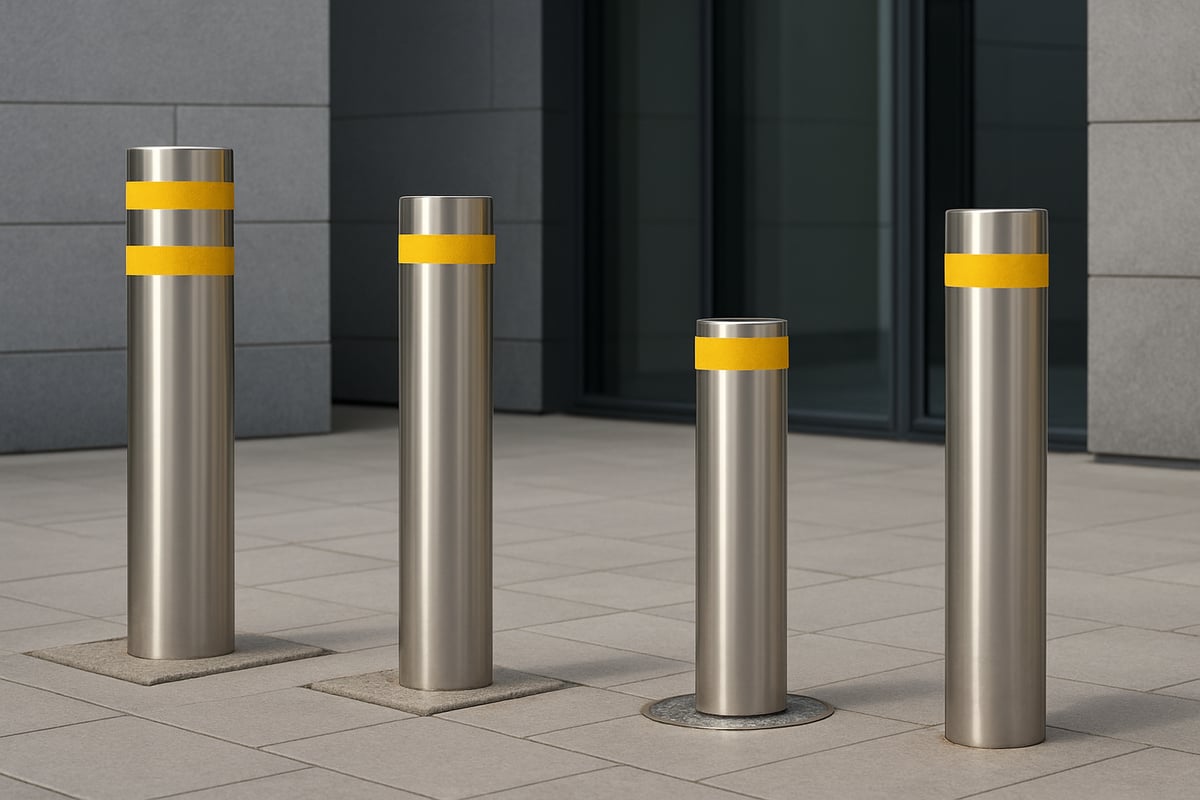
Material and Build Quality
Material choice is foundational when evaluating heavy duty security bollards. The three most common materials—steel, stainless steel, and aluminium—each offer distinct advantages:
| Material | Durability | Corrosion Resistance | Typical Use |
|---|---|---|---|
| Steel | Excellent | Moderate | High-impact areas |
| Stainless Steel | Excellent | High | Coastal, urban |
| Aluminium | Good | High | Decorative, light |
Steel remains the preferred choice for impact resistance, while stainless steel excels in environments exposed to moisture or salt. Aluminium is lighter but less suited for high-security applications.
Look for impact ratings and crash test certifications such as PAS 68 and IWA 14, which confirm a bollard’s ability to withstand vehicle attacks. For more on these certifications and their importance, see PAS 68 bollards and barriers. Always ensure your heavy duty security bollards have weatherproof finishes to prevent rust and extend their lifespan.
Security Performance
The main function of heavy duty security bollards is to resist unauthorised vehicle access, ram raids, and even terrorist attacks. Anti-ram and anti-terror bollards are engineered with reinforced cores and deep foundations to withstand high-speed impacts.
Security features include resistance to forced removal, tamper-proof fixings, and robust locking mechanisms for retractable or removable models. Modern designs also incorporate anti-drill and anti-cut technologies. When choosing heavy duty security bollards, prioritise those that offer proven performance under real-world attack scenarios.
Visibility and Safety Enhancements
Visibility is crucial for both safety and deterrence. Heavy duty security bollards should be easily seen by drivers and pedestrians, reducing the risk of accidental collisions.
Key enhancements include:
- High-visibility colours such as yellow and black or red and white
- Reflective strips to improve night-time visibility
- LED illumination for enhanced awareness in low light
Designs should also eliminate trip hazards by ensuring smooth transitions at ground level. These features make heavy duty security bollards effective at protecting people and property in all conditions.
Customisation and Aesthetics
Heavy duty security bollards are available in a range of finishes, colours, and sizes to suit different environments. Custom powder coating allows for branding or blending with surrounding architecture.
Bollards can be tailored in height, width, or design to meet unique site requirements. Some models offer architectural detailing or decorative elements, ensuring security solutions do not detract from the visual appeal of a property.
Integrating heavy duty security bollards with landscaping or building design delivers both protection and a cohesive look that enhances the overall environment.
Compliance, Standards, and Regulations for 2025
As the demand for heavy duty security bollards rises, understanding compliance, standards, and regulations has never been more important. Whether you are safeguarding a commercial site or a public space, strict adherence to legal and safety requirements ensures your installation is both effective and lawful.
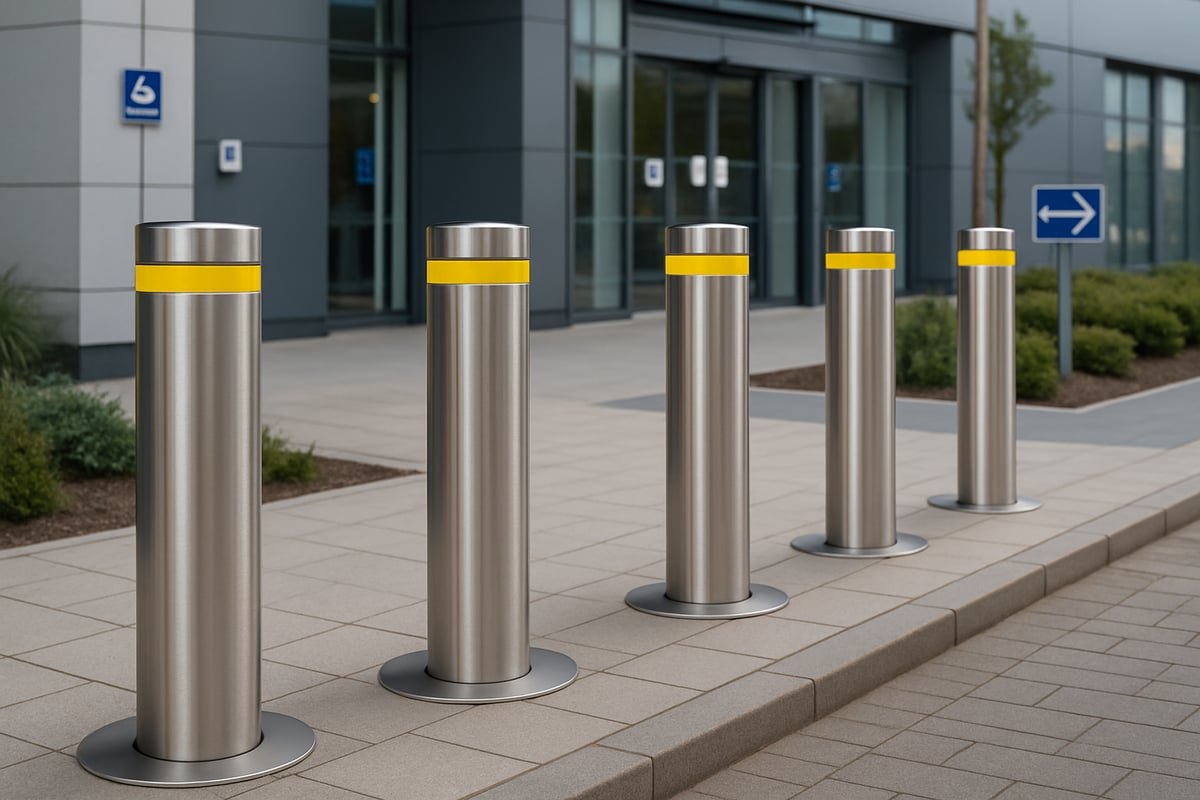
UK and International Standards
Heavy duty security bollards in the UK are governed by rigorous standards to ensure maximum protection and reliability. PAS 68 and IWA 14 are the primary crash test certifications, setting out requirements for impact resistance and structural integrity. These standards help buyers evaluate bollards based on real-world vehicle impact scenarios.
Crash test ratings indicate how well a bollard can stop a moving vehicle, providing peace of mind for property owners. CE marking confirms products meet relevant European safety directives. For a detailed summary of UK-specific regulations, refer to the UK bollard regulations overview, which covers essential design and placement rules.
Planning Permission and Legal Considerations
Installing heavy duty security bollards may require planning permission, especially in public or listed areas. Property owners and facility managers are responsible for ensuring installations comply with local authority guidelines.
Permissions are often needed if the bollards impact pedestrian pathways or alter public highways. Consulting with local planning departments prior to installation helps avoid costly mistakes. Compliance with legal requirements protects both users and organisations from liability.
Accessibility and Inclusivity
When specifying heavy duty security bollards, accessibility is a top priority. Installations must not obstruct disabled access or contravene the Disability Discrimination Act (DDA). In public spaces, bollard placement and design should support inclusive navigation for all users.
Features such as contrasting colours, tactile surfaces, and correct spacing help ensure compliance. Examples include bollards with integrated guidance strips or those designed for easy visibility by visually impaired individuals. Prioritising inclusivity enhances both safety and user experience.
Environmental and Sustainability Regulations
Sustainability regulations now shape the manufacturing and selection of heavy duty security bollards. Many local authorities require the use of recyclable materials and environmentally friendly coatings. Eco-conscious buyers should seek products made with low-carbon processes and responsible sourcing.
Choosing suppliers who demonstrate sustainable practices can help meet local green initiatives. Regular audits and certifications, such as ISO 14001, signal a commitment to environmental responsibility. Sustainable bollards not only protect assets but also support broader environmental goals.
Choosing the Right Heavy Duty Security Bollards
Selecting the most effective heavy duty security bollards for your property requires a careful, methodical approach. Each site presents unique challenges, so making the right choices can significantly improve safety and peace of mind.
Site Assessment and Risk Analysis
Start by conducting a thorough site assessment to identify threats and vulnerabilities specific to your location. Analyse vehicle approach speeds, common traffic patterns, and potential impact zones. Consider how vehicles could access or threaten sensitive areas, such as entrances, loading bays, or pedestrian walkways.
Consulting with experienced security professionals is highly recommended. They can provide tailored recommendations for heavy duty security bollards that address your unique risks. This initial analysis forms the foundation for an effective bollard strategy and ensures your investment delivers maximum protection.
Matching Bollard Type to Application
Choosing the correct bollard type depends on your site's requirements and daily operations. Fixed bollards offer permanent, robust security for areas needing constant protection, such as shopfronts or utilities. Removable and telescopic bollards provide flexibility for sites with changing access needs, like car parks or event spaces. Automatic bollards are ideal for high-traffic locations where access control is essential.
For example, retail parks often use fixed or anti-ram bollards, while schools may prefer telescopic models for flexible entry points. Always balance the security benefits of heavy duty security bollards with any access requirements to avoid disrupting daily activities.
Budget and Lifecycle Costs
When planning your investment, evaluate both the initial and long-term costs. Upfront expenses include the price of the heavy duty security bollards themselves, installation fees, and any necessary groundworks. Ongoing costs cover maintenance, inspections, and potential repairs or upgrades.
Consider the value for money each bollard type offers. For instance, fixed bollards usually have lower maintenance costs, while automatic models may require more frequent servicing. Typical price ranges can vary from several hundred to several thousand pounds per unit, depending on specifications and features.
Supplier Selection and Product Quality
Choosing a reputable UK manufacturer is essential for product reliability and after-sales support. Look for suppliers who offer comprehensive warranties, installation services, and ongoing maintenance packages. Assess their credentials, customer testimonials, and industry accreditations to ensure you are investing in trustworthy heavy duty security bollards.
Quality assurance is vital. High-quality bollards are more durable, require less frequent replacement, and provide consistent protection. Take time to compare suppliers and prioritise those with proven experience in your sector.
Bison Products: British-Made Security Bollards
Since 1972, Bison Products has been a leading name in the design, manufacture, and installation of heavy duty security bollards across the UK. Their range includes telescopic, anti-ram, static, and removable models to suit residential, commercial, and public sector needs.
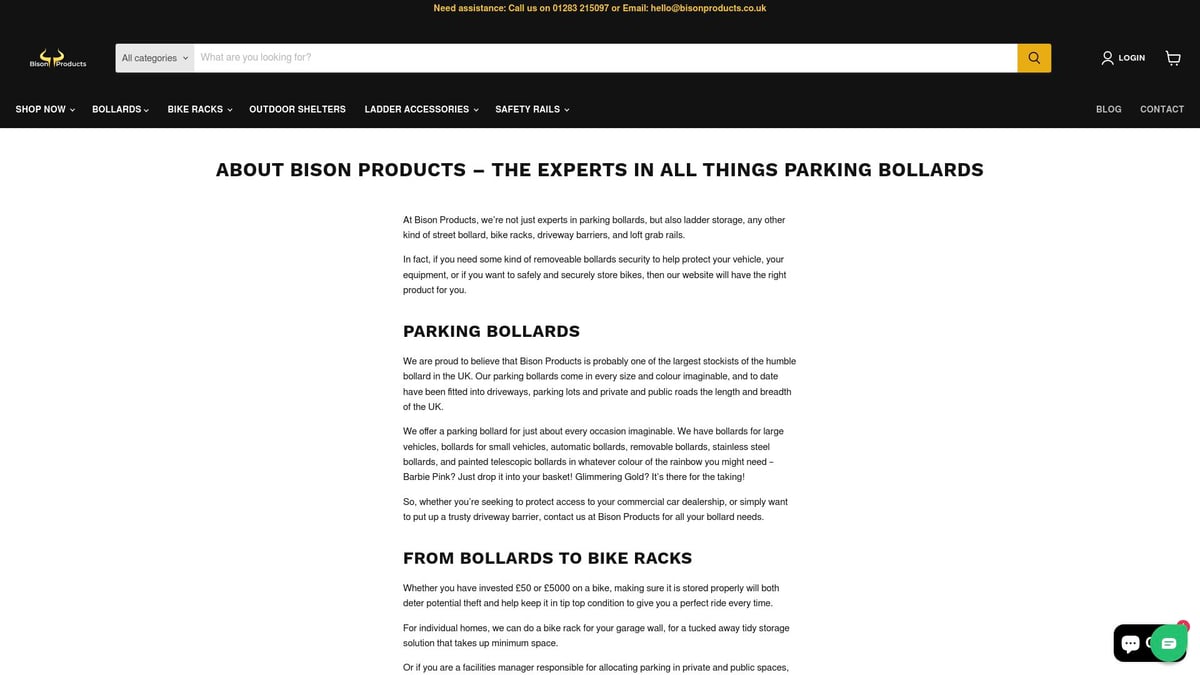
Bison Products stands out for its commitment to British manufacturing quality, flexible customisation options, and expert support. Clients benefit from durable materials, a wide selection of finishes, and tailored installation solutions. For those seeking trusted expertise and robust security, Bison Products offers comprehensive solutions for every requirement.
Installation and Maintenance Best Practices
Proper installation and upkeep are essential to ensure heavy duty security bollards deliver maximum protection for years to come. Whether you manage a business, public space, or private property, following best practices can help you avoid costly mistakes and maintain robust security.
Professional vs. DIY Installation
Choosing between professional installation and a DIY approach is a key decision when investing in heavy duty security bollards. Professional fitting ensures compliance with safety standards, accurate site preparation, and reliable anchoring. Experts assess ground conditions, plan layouts, and use proper equipment to secure each bollard.
DIY installation may be suitable for simpler models, but it can lead to errors in alignment, depth, or fixing. These mistakes might compromise bollard performance. Professional services, such as those outlined in the Security Bollards Installation Services, offer peace of mind through experienced teams and guarantees. For critical sites or automatic bollards, always opt for professional installation of heavy duty security bollards.
Ongoing Maintenance and Inspection
Routine maintenance is vital for keeping heavy duty security bollards effective and reliable. Regularly inspect each unit for signs of damage, corrosion, or tampering. Check locking mechanisms and ensure moving parts, such as those in telescopic or automatic bollards, operate smoothly.
Cleaning schedules should match the material and finish. Use mild detergents for stainless steel and avoid abrasive tools on painted surfaces. Lubricate hinges or retractable sections as needed. By following these steps, you extend the lifespan and security performance of heavy duty security bollards.
Repair, Replacement, and Upgrades
Over time, heavy duty security bollards may sustain impact damage or wear. Knowing when to repair versus replace is crucial. Minor dents or surface corrosion can often be fixed with appropriate treatments, while structural damage or compromised locking systems require replacement.
Consider upgrading to smart or higher-rated bollards as security threats evolve. Proactive upgrades can include adding sensors, LED lighting, or improved locking mechanisms. With proper care, the lifecycle of heavy duty security bollards can be significantly extended, protecting your site for years to come.
Common Installation Challenges and Solutions
Several challenges can arise during the installation of heavy duty security bollards. Underground utilities, such as gas or water lines, require careful surveying before any excavation. Uneven ground may need additional groundwork or custom mounting solutions.
Restricted access in busy urban areas can complicate installation. Plan works during off-peak hours to reduce disruption. Always ensure local regulations are followed, and obtain any necessary permissions. Addressing these challenges early helps ensure a smooth installation process for heavy duty security bollards.
Maintenance Schedules and Documentation
Keeping accurate maintenance logs is essential for compliance and asset management. Record each inspection, cleaning, and repair. Set a schedule for routine checks, typically every 3–6 months, depending on usage and location.
| Maintenance Task | Frequency | Responsible Person | Notes |
|---|---|---|---|
| Visual Inspection | Monthly | Site Manager | Check for damage, tampering |
| Cleaning | Quarterly | Maintenance Team | Use suitable cleaners |
| Lubrication | Biannually | Technician | For moving parts |
Organised documentation not only prolongs the lifespan of heavy duty security bollards but also streamlines future upgrades and compliance audits.
Future Trends in Heavy Duty Security Bollards
The landscape of security is rapidly evolving, and so too are the demands placed on heavy duty security bollards. As cities become smarter and threats more sophisticated, the next generation of bollards is being shaped by technology, sustainability, and urban design. Looking ahead to 2025 and beyond, here are the trends set to define the future of heavy duty security bollards.
Integration with Smart Security Systems
One of the most significant trends is the integration of heavy duty security bollards with advanced smart security systems. Modern bollards can now connect directly to CCTV, alarms, and access control panels, allowing real-time monitoring and rapid response to incidents. Features such as remote operation, automatic locking, and sensor-based activation are becoming standard in high-risk areas.
For those considering installation, resources like the High-security bollard installation guide provide detailed insights into technical requirements and certification standards. As the need for intelligent perimeter protection grows, heavy duty security bollards are becoming a cornerstone of holistic security strategies.
Advanced Materials and Eco-Innovation
Manufacturers are investing in advanced materials to deliver lighter yet stronger heavy duty security bollards. Composite materials, high-grade steel alloys, and reinforced concrete are now used to maximise impact resistance while reducing environmental impact. Many models incorporate recyclable components and low-carbon production techniques.
Eco-friendly coatings, such as powder finishes and water-based paints, are being adopted to further reduce the carbon footprint. This shift ensures that heavy duty security bollards not only protect people and assets but also contribute to broader sustainability goals within urban environments.
Urban Design and Aesthetic Integration
A growing trend is the seamless integration of heavy duty security bollards into urban design. Architects and planners are opting for custom finishes, colours, and shapes that blend with the surrounding environment. This approach ensures that security measures do not detract from the aesthetic appeal of city centres and public spaces.
By working closely with designers, manufacturers now offer bollards that incorporate branding, public art, or even serve dual purposes, such as seating or lighting. This trend allows heavy duty security bollards to enhance the visual identity of an area while maintaining robust protection.
Evolving Threats and Security Demands
As criminal tactics change and new risks emerge, heavy duty security bollards must adapt accordingly. The rise of electric vehicles, changes in urban traffic flow, and evolving threat vectors mean that bollards require updated specifications and certifications. Crash testing, such as those showcased at the Crash-tested bollards at International Security Expo, highlights the latest advancements in impact resistance and tamper-proof design.
Regulations are also evolving to address these new challenges. Security professionals must stay informed to ensure that their heavy duty security bollards meet the highest standards of protection and compliance.
Predictions for 2025 and Beyond
Looking forward, we can expect further innovation in the field of heavy duty security bollards. Integration with AI-driven monitoring, increased use of sustainable materials, and even more creative urban applications will become common. As security and urban planning continue to converge, heavy duty security bollards will play a pivotal role in shaping safer, smarter cities.
Having explored the key features, compliance standards, and future trends shaping heavy duty security bollards in 2025, you now have the insight needed to make an informed decision for your property or project. Whether you are safeguarding a business, public space, or residential site, selecting the right bollard is essential for lasting protection and peace of mind. If you are ready to take the next step and want expert guidance from experienced British manufacturers, you can Get a free quote tailored to your exact requirements. Let us help you secure your site with confidence.

